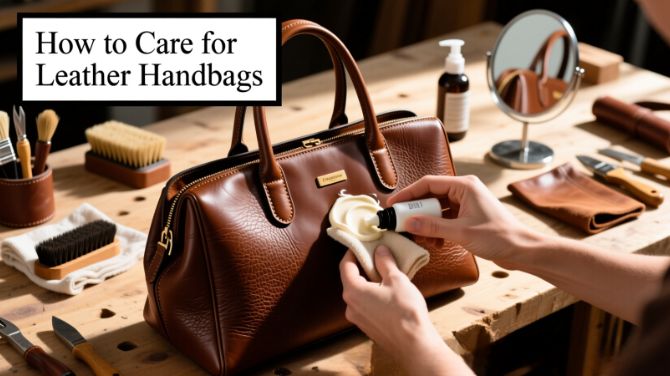Learning how to care for leather handbags protects your investment and keeps your bag looking great for years. This guide gives step-by-step cleaning, conditioning, storage, and stain-removal advice for all common leather types. Read on for practical routines, product suggestions, and museum-backed storage tips.
Why learning how to care for leather handbags matters
Leather is a natural, porous material. Proper care prevents drying, cracking, stains, and color change. A well-cared-for leather bag can last decades, while neglected leather can fail in a few years. Museum conservators and leading lifestyle outlets agree on basic rules: keep leather dry, clean gently, condition periodically, and store with climate in mind.
Quick overview: What this guide covers
- A straightforward, repeatable routine for owners who want to know how to care for leather handbags.
- How to identify leather types and why that matters.
- Step-by-step cleaning and conditioning instructions.
- Safe stain removal methods and what to avoid.
- Storage, travel, and daily handling tips that prevent damage.
- FAQs and product suggestions based on expert guidance.
Know your leather: types and what they require
Not all leather is the same. Match care to the type before you clean.
Major leather types
- Full-grain leather — strongest and most durable. Ages well with light care.
- Top-grain leather — slightly treated surface. Easier to clean.
- Corrected-grain or split leather — may be coated or embossed; avoid heavy oils.
- Suede and nubuck — textured finishes; need special brushes and are more absorbent.
When you learn how to care for leather handbags, identify the leather first. Manufacturers’ tags, receipts, or the retailer can say which leather you own. If in doubt, test any product on an inconspicuous spot. Glamour
Daily and weekly maintenance routine
A simple routine prevents big problems. Follow these steps to preserve appearance and structure.
Daily
- Wipe dust and grit off with a soft, dry cloth.
- Keep liquids away; blot spills immediately with a dry cloth.
- Avoid overstuffing to preserve shape.
Weekly
- Brush textured surfaces (suede, nubuck) with a dedicated suede brush.
- Check hardware and seams for loose threads or tarnish.
Monthly (or every 4–6 weeks)
- Light clean with a damp cloth for treated leathers, then dry.
- Inspect color and dryness; condition if leather feels tight or looks matte.
When you adopt these habits you dramatically reduce the need for restoration. This is the core of how to care for leather handbags day to day.
Deep cleaning and conditioning: step-by-step
Deep cleaning and conditioning restore oils and remove embedded dirt. Use mild products and test first.
Materials you’ll need
- Soft, lint-free cloths.
- Mild leather cleaner or saddle soap (product-specific).
- pH-neutral leather conditioner (example: Leather Honey or similar).
- Soft brush for textured leather.
- Cotton swabs for crevices.
Step 1 — Dust and surface dirt
Wipe the bag with a dry cloth to remove dust. Use a soft brush for seams and stitching.
Step 2 — Spot test
Apply cleaner to a hidden area. Wait 10 minutes. Ensure no color loss or finish change.
Step 3 — Clean
Apply cleaner sparingly to a cloth. Gently rub in circular motions. Avoid soaking the leather. For suede, use a suede cleaner and brush only.
Step 4 — Dry
Air dry at room temperature. Do not use a heater or direct sunlight.
Step 5 — Condition
Apply a thin, even coat of leather conditioner. Rub gently until absorbed. Remove excess with a clean cloth. For new or very dry leather, a second light coat may help.
Timing
- Deep clean once per season for regular use.
- Condition every 3–6 months for treated leathers. Less for high-oil leathers; more for dry climates.
These steps form the backbone of how to care for leather handbags properly.
Stain removal: common stains and safe fixes
Act fast. Different stains need different methods.
Water marks
- Blot excess immediately.
- Dry naturally, then condition to restore oils. Avoid rubbing, which spreads the mark.
Oil or grease
- Absorb as much as possible with cornstarch or talc.
- Leave overnight, brush off, then clean gently.
- Repeat if needed. Oils often require professional attention if old.
Ink
- Use alcohol sparingly on finished leather and test first.
- For valuable bags, seek professional help. Aggressive solvents damage dyes and finish.
Mold or mildew
- Brush away dry mold outdoors.
- Wipe with a cloth lightly dampened with a mixture of water and a small amount of rubbing alcohol, then dry fully. If spread or deep, consult a pro. Museum guidance stresses dry, climate-controlled storage to prevent mold growth.
When dealing with stains, remember your priority: stop further damage. That is the practical heart of how to care for leather handbags.
Water, weather, and wearing leather in different climates
Water and sunlight are natural enemies of leather.
Rain
- Avoid using a leather bag in heavy rain.
- If leather gets wet, blot, then air dry. Condition after drying to replace lost oils.
Sun and heat
- Prolonged sun fades dyes and dries the leather.
- Store out of direct sunlight.
Humidity
- High humidity encourages mold.
- Low humidity dries leather and causes cracking.
- Aim to store at stable humidity (around 40%–55%) when possible. Museum storage guidelines recommend controlled environments for leather objects.
These environmental tips are essential to mastering how to care for leather handbags in real life.
Storage and travel: keeping shape and preventing damage
How you store or transport leather makes a big difference.
Storage best practices
- Keep in breathable dust bags; avoid plastic which traps moisture.
- Stuff the bag with acid-free tissue to hold shape.
- Store upright on a shelf; do not hang by handles for long periods.
- Avoid stacking heavy items on top.
Travel tips
- Use a protective cover or wrap to prevent scuffs.
- Keep electronics and liquids in separate pouches to avoid spills.
- Pack in a way that preserves shape — fill cavities with soft items.
Follow these steps whenever you think about how to care for leather handbags during downtime or travel.
Hardware, zippers, and repairs
Small repairs now prevent big problems later.
Hardware care
- Wipe metal parts with a soft cloth.
- For stubborn tarnish, use a jeweler’s cloth. Avoid getting polish on leather.
Zippers
- Keep zippers clean; apply a tiny amount of beeswax or zipper lubricant if they stick.
Sewing and structural repairs
- Address loose stitching early. Small fixes are inexpensive compared with full restoration.
- For vintage or designer bags, use an authorized repair service.
These practical steps help preserve both look and function, and are part of any clear plan for how to care for leather handbags.
Product picks and what professionals recommend
Professionals and conservators recommend pH-neutral, non-solvent products.
- Leather-specific cleaners and conditioners — choose established brands with clear instructions. Many trusted home-care guides recommend Leather Honey products for household use, though some restorers caution about potential darkening on certain leathers. Always test first.
- Suede brushes and erasers for textured finishes.
- Museum-grade storage materials such as acid-free tissue for long-term care.
If reselling a bag is a goal, research whether conditioning will change patina or color, since some products can darken leather.
Case study: a 5-year maintenance plan
A short example shows impact of routine care.
Scenario
- A daily-use full-grain leather tote, used year-round.
Plan
- Weekly dust wipe and monthly surface check.
- Deep clean and condition every three months.
- Annual hardware inspection and professional service every 2–3 years.
Outcome
- After five years, the tote shows natural patina but no cracking, minimal stains, and intact stitching — a clear win for applying how to care for leather handbags consistently. This mirrors lifecycle advice from lifestyle experts.
Quick checklist: daily, monthly, yearly
Daily
- Wipe dust, avoid overstuffing, blot spills.
Monthly
- Light clean, inspect seams, brush suede.
Every 3–6 months
- Deep clean and condition for most treated leathers.
Yearly
- Professional inspection for vintage, delicate, or heavily used bags.
Keeping a simple checklist is one of the easiest ways to remember how to care for leather handbags.
FAQs — optimized for search and voice queries
Q: How often should I clean leather handbags?
A: Light cleaning weekly, deep cleaning and conditioning every 3–6 months for most treated leathers. High-use bags may need more frequent care.
Q: Can I use household cleaners on leather handbags?
A: Avoid household cleaners that contain alcohol, bleach, or harsh detergents. Use products made for leather and test on a hidden area first.
Q: Will conditioning darken my leather handbag?
A: Some conditioners can slightly darken leather. Test first and apply a thin coat. For pieces you plan to resell, consult a professional before treating.
Q: How do I remove ink from a leather handbag?
A: Ink is difficult. Try alcohol on a cotton swab in a hidden area first. For valuable bags, go to a professional.
Q: What is the best way to store leather handbags long-term?
A: Store in breathable dust bags, use acid-free tissue for shape, and keep in a cool, stable, and dry place away from sunlight. Museum guidance supports climate-controlled storage for long-term preservation.
These FAQs are engineered to match common long-tail searches about how to care for leather handbags.
Internal linking suggestions (for your website)
Add these internal links to improve site architecture and SEO:
- How to Store Handbags Long Term
- Choosing the Right Leather Cleaner for Your Bag
- Suede vs Smooth Leather: Care Differences
- How to Spot Fake Leather vs Real Leather
External authority references
For further reading and expert guidance:
- National Park Service: Curatorial care of leather objects.
- Southern Living: How to clean leather step-by-step.
- The Guardian: Practical leather-care tips and product notes.
- Byrdie and Glamour: designer and lifestyle recommendations for bag care.
Citing high-quality sources supports E-E-A-T and helps readers trust the advice.
Final checklist: 12-minute routine you can do now
- Empty your bag and remove crumbs.
- Wipe interior and exterior with a dry cloth.
- Spot-test a cleaner if needed.
- Clean small areas with a lint-free cloth.
- Let air dry.
- Apply a pea-size amount of conditioner to a cloth.
- Buff lightly after absorption.
- Re-shape with tissue.
- Place in dust bag.
- Inspect hardware.
- Store upright.
- Log next conditioning date in your phone calendar.
This quick routine is a practical distillation of how to care for leather handbags without overcomplicating things.
Conclusion
How to care for leather handbags is a set of consistent habits: identify your leather, clean gently, condition appropriately, store smartly, and seek professional help for serious damage. Follow the step-by-step routines and checks above to protect your investment and enjoy your bag for years. Ready to protect your favorite piece? Start with a light cleaning and a spot test today.



